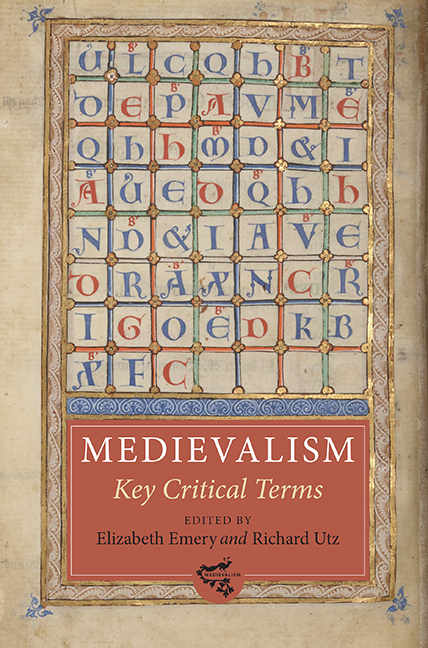Book contents
- Frontmatter
- Dedication
- Contents
- List of Illustrations
- List of Contributors
- Making Medievalism: A Critical Overview
- 1 Archive
- 2 Authenticity
- 3 Authority
- 4 Christianity
- 5 Co-disciplinarity
- 6 Continuity
- 7 Feast
- 8 Genealogy
- 9 Gesture
- 10 Gothic
- 11 Heresy
- 12 Humor
- 13 Lingua
- 14 Love
- 15 Memory
- 16 Middle
- 17 Modernity
- 18 Monument
- 19 Myth
- 20 Play
- 21 Presentism
- 22 Primitive
- 23 Purity
- 24 Reenactment
- 25 Resonance
- 26 Simulacrum
- 27 Spectacle
- 28 Transfer
- 29 Trauma
- 30 Troubadour
- Index
- Medievalism
30 - Troubadour
Published online by Cambridge University Press: 08 October 2022
- Frontmatter
- Dedication
- Contents
- List of Illustrations
- List of Contributors
- Making Medievalism: A Critical Overview
- 1 Archive
- 2 Authenticity
- 3 Authority
- 4 Christianity
- 5 Co-disciplinarity
- 6 Continuity
- 7 Feast
- 8 Genealogy
- 9 Gesture
- 10 Gothic
- 11 Heresy
- 12 Humor
- 13 Lingua
- 14 Love
- 15 Memory
- 16 Middle
- 17 Modernity
- 18 Monument
- 19 Myth
- 20 Play
- 21 Presentism
- 22 Primitive
- 23 Purity
- 24 Reenactment
- 25 Resonance
- 26 Simulacrum
- 27 Spectacle
- 28 Transfer
- 29 Trauma
- 30 Troubadour
- Index
- Medievalism
Summary
THE LATE EIGHTEENTH century in Britain and continental Europe was a period in which a rebellion against both Hobbesian pessimism and Enlightenment rationalism manifested as a reinvestment in the sentiments and the passions. If the Enlightenment was characterized by a renewed appreciation for classical stoicism and Socratic reason, the following period of Romantic reaction found that the medieval period offered previously disregarded terrain for affective investment; if the Enlightenment embraced a cosmopolitan ethos in philosophy and political theory, the Romantic period experienced a deeply nationalistic tendency. Nationalist feeling swept across Europe and throughout Britain, colliding with the more global purview of cosmopolitan urbanity; reexamination of earlier, especially native, histories, accompanied by the new focus on aesthetic theory and aesthetic appreciation, revealed that in pre-Roman artifacts and medieval ruins lay the clues to one's own and one's nation's cultural past.
While antiquarians labored to recover, decipher, catalog, and reinterpret relics of the pre-Roman and medieval past, writers and the public at large, particularly in Britain, felt freer imaginatively to resuscitate the past in ways that could exploit the aesthetic elements of surviving historical spaces such as ruined abbeys and castles. At the same time this cultural labor provided a reconstructed cultural lineage that could embellish newly important published peerages and other reference works documenting family genealogies. Arms and armor not necessarily from the family storerooms became fashionable décor for estates, while lesser ranked families made do with painted medieval scenes or print versions such as John Boydell commissioned for his Shakespeare Gallery.
This essay will first survey the more general approach to medievalism in the British Romantic period, and then address the more specific appeal of the troubadour to both Romantic poets and their readers. Indeed, the link between a vaguer medieval sensibility and the figure of the troubadour poet was a strong one, beginning in the 1760s and lasting until chivalry came to stand in for medieval culture by the 1840s and 1850s. For the reading public Petrarch represented the very person of the troubadour; he was as much a literary touchstone as Shakespeare, his love sonnets appealing to the late eighteenth-century cult of sensibility, with this appeal hardly lessening in subsequent decades.
- Type
- Chapter
- Information
- Medievalism: Key Critical Terms , pp. 255 - 264Publisher: Boydell & BrewerPrint publication year: 2014



